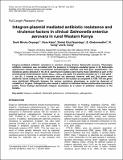| dc.contributor.author | David Miruka Onyango, Rose Kakai, Waindi Eliud Ny, B Ghebremedhin, W Konig, B Kong | |
| dc.date.accessioned | 2020-08-27T12:30:40Z | |
| dc.date.available | 2020-08-27T12:30:40Z | |
| dc.date.issued | 2010-07-31 | |
| dc.identifier.citation | 9 | en_US |
| dc.identifier.uri | https://repository.maseno.ac.ke/handle/123456789/2473 | |
| dc.description.abstract | Integron-mediated antibiotic resistance is common among diverse Salmonellaserovars. Phenotypic antibiotic resistance was correlated with the presence of intergron–mediated genes in 65 Salmonella typhimurium isolates using conventional microbiological methods and PCR gene amplification. The resistance genes detected in the 20 S. typhimurium isolates were mainly those identified as part of the chromosomal multiresistance cluster balPSE-1, blaTEM and aadA. The plasmid encoded sul 1/ 2 and aphA - 1, aac (6) -1 located on the chromosome were not observed, however strB and Grm genes were observed. Genes coding for PSE -1 was predominant in the isolates as compared to TEM. The two genes were distributed differently between the various resistance phenotypes as could be observed of variability in int gene. Pathogenicity also varied in relation to individual isolate antimicrobial mechanism profile. These findings demonstrate integron mechanism as a means of antibiotic resistance in the isolates. | en_US |
| dc.publisher | Academic Journals | en_US |
| dc.subject | Intergron–mediated, Salmonella typhimurium, multiresistance, pathogenicity. | en_US |
| dc.title | Integron-plasmid mediated antibiotic resistance and virulence factors in clinical Salmonella enterica serovars in rural Western Kenya | en_US |
| dc.type | Article | en_US |

